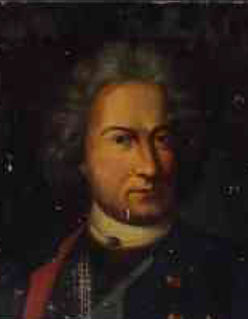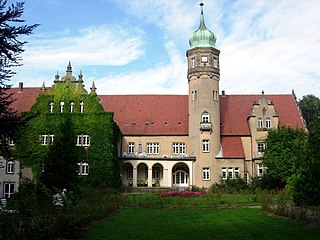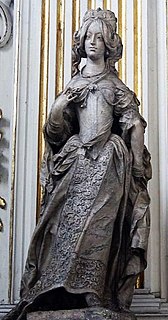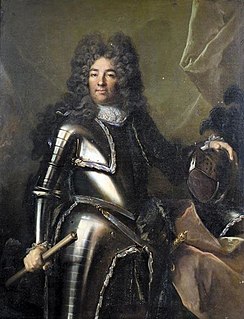
The House of Glücksburg, shortened from House of Schleswig-Holstein-Sonderburg-Glücksburg, is a collateral branch of the German House of Oldenburg, members of which have reigned at various times in Denmark, Norway, Greece, and several northern German states.

The House of Schleswig-Holstein-Sonderburg-Augustenburg was a branch of the dukes of Schleswig-Holstein-Sonderburg of the House of Oldenburg. The line descended from Alexander, Duke of Schleswig-Holstein-Sonderburg. Like all of the secondary lines from the Sonderburg branch, the heads of the House of Schleswig-Holstein-Sonderburg-Augustenburg were first known as Dukes of Schleswig-Holstein and Dukes of Sonderburg. The family took its name from its ancestral home, Augustenborg Palace in Augustenborg, Denmark.

Peter August Friedrich, Duke of Schleswig-Holstein-Sonderburg-Beck was a Duke of Schleswig-Holstein-Sonderburg-Beck. He was the fifth and youngest son of Frederick Louis, Duke of Schleswig-Holstein-Sonderburg-Beck and his wife Duchess Louise Charlotte of Schleswig-Holstein-Sonderburg-Augustenburg.

Frederick Louis of Holstein-Sonderburg-Beck was a Duke of Schleswig-Holstein-Sonderburg-Beck and field marshal of the Prussian Army. He was the son of August Philipp, Duke of Schleswig-Holstein-Sonderburg-Beck and Countess Marie Sibylle of Nassau-Saarbrücken.

Alexander, Duke of Schleswig-Holstein-Sonderburg, was a Danish nobleman.

Löhne is a town in the district of Herford, in North Rhine-Westphalia, Germany.

Ernest Günther of Schleswig-Holstein-Sonderburg-Augustenburg was a Duke of Schleswig-Holstein of its Sonderborg line. He was the first to have his ducal seat in Augustenborg Palace, which he built and named in honor of his wife. He ruled from 1647 until his death in 1689.

Maurice of Saxe-Zeitz was a duke of Saxe-Zeitz and member of the House of Wettin.

Brandenburg-Schwedt was a secundogeniture of the Hohenzollern margraves of Brandenburg, established by Prince Philip William who took his residence at Schwedt Castle in 1689. By appanage, they administered the manors of Schwedt and Vierraden on the Oder river as well as Wildenbruch in Pomerania. Though prosperous, the cadet branch never obtained Imperial immediacy.

Schleswig-Holstein-Sonderburg was the name of a branch line of the House of Oldenburg as well as the name of their land. It existed from 1564 until 1668 and was a titular duchy under the King of Denmark, rather than a true territorial dukedom in its own right. The seat of the duke was Sønderborg. Parts of the domain were located in Denmark, mainly on the islands of Als and Ærø and around Glücksburg, whilst other lands were part of the Holy Roman Empire, including the Ämter of Plön, Ahrensbök, and Reinfeld. As a result of various inheritance arrangements it fragmented into numerous small territories which were eventually absorbed into Greater Denmark in the 18th century.

Princess Dorothea of Schleswig-Holstein-Sonderburg-Glücksburg, was Duchess consort of Brunswick-Lüneburg by marriage to Christian Louis, Duke of Brunswick-Lüneburg, and Electress of Brandenburg by marriage to Frederick William, Elector of Brandenburg, the "Great Elector".

Karolina of Legnica-Brieg-Wohlau, was a Silesian noble, duchess of Legnica, Brzeg and Wołów and the last member of the Silesian Piasts dynasty. She was the eldest daughter of Christian, Duke of Brieg and Louise of Anhalt-Dessau. After the death of her father, she married secretly without the knowledge of her mother on 14 July 1672 to Duke Frederick von Schleswig-Holstein-Sonderburg-Wiesenburg and also became the duchess of Schleswig-Holstein-Sonderburg-Wiesenburg.

The Duchy of Schleswig-Holstein-Sonderburg-Plön, also Schleswig-Holstein-Plön, Holstein-Plön or just Duchy of Plön, was a small sub-duchy (Teilherzogtum) created by the physical division of the Duchy of Schleswig-Holstein-Sonderburg. Today, its remaining significance is primarily the building of Plön Castle. The Duchy of Plön was not a territorial dukedom in its own right, but a sub-division within the state structure of the duchies of Schleswig and Holstein. The scattered territorial dominion lay mostly in the southeast part of present-day German state of Schleswig-Holstein.

Joachim Frederick of Schleswig-Holstein-Sonderburg-Plön, also known as Joachim Frederick of Schleswig-Holstein-Plön, was the third Duke of Schleswig-Holstein-Plön, a dukedom created by the division of the Duchy of Schleswig-Holstein-Sonderburg.
Eleonore Charlotte of Saxe-Lauenburg-Franzhagen was a duchess of Saxe-Lauenburg by birth and, by marriage, Duchess of Schleswig-Holstein-Sonderburg-Franzhagen, whose line and territorial legacy she co-founded.

Philip Louis of Schleswig-Holstein-Sonderburg-Wiesenburg was the founder and first duke of the line Schleswig-Holstein-Sonderburg-Wiesenburg. His branch of the House of Schleswig-Holstein-Sonderburg is named after Wiesenburg Castle, near Zwickau.

Frederick I of Hesse-Homburg, was the first Landgrave of Hesse-Homburg and founder of the eponymous family line.
Anna Margaret of Hesse-Homburg,, was a Landgravine of Hesse-Homburg by birth and by marriage Duchess of Schleswig-Holstein-Sonderburg-Wiesenburg.

Sophie Elisabeth of Schleswig-Holstein-Sonderburg-Wiesenburg, was a German noblewoman member of the House of Oldenburg and by marriage Duchess of Saxe-Zeitz.
















